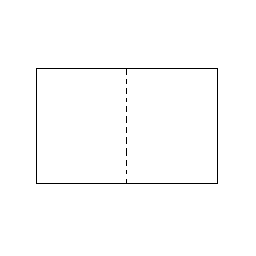

If you are searching for instructions on paper flying wings then you have come to the right place.
These easy step by step instructions should do the trick. This particular glider has critical aerodynamic features which must be created accurately to achieve good flight characteristics. If you complete the first steps properly, the final trimming for flight should come with a few tries. I've shown many people my gliders and most have learned quickly.
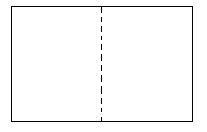 You should start with a good sheet of 11 x 8.5 regular stock paper. Printer paper happens to make excellent gliders. You will need a pair of scissors for this glider because we need to remove approximately 60% of the weight from the paper. While your paper lies on a flat surface in a landscape orientation, fold it down the centre to form a reference crease. Unfold the paper flat and proceed to the second step.
You should start with a good sheet of 11 x 8.5 regular stock paper. Printer paper happens to make excellent gliders. You will need a pair of scissors for this glider because we need to remove approximately 60% of the weight from the paper. While your paper lies on a flat surface in a landscape orientation, fold it down the centre to form a reference crease. Unfold the paper flat and proceed to the second step.
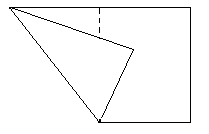 Fold the left - bottom corner of the paper over to the right. The crease you form must run as straight as possible from the top - left corner to the bottom - centre of the sheet. And again, the same fold on the right side to form a symmetrical triangle. A good effort in accuracy here will pay off later when it gets more complicated.
Fold the left - bottom corner of the paper over to the right. The crease you form must run as straight as possible from the top - left corner to the bottom - centre of the sheet. And again, the same fold on the right side to form a symmetrical triangle. A good effort in accuracy here will pay off later when it gets more complicated. 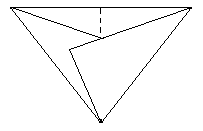
 Now we make a fold which will determine a number of factors. First, it will define the front of the glider. Second, it will create a template to show us an additional 10% of unneeded paper that we will remove with the scissors. Fold the bottom point up to just slightly higher than 50% of the single ply. This will be approximately one inch from the edge. While holding the paper in this position, being careful not to crease it, carefully cut away the single ply of paper with your scissors.
Now we make a fold which will determine a number of factors. First, it will define the front of the glider. Second, it will create a template to show us an additional 10% of unneeded paper that we will remove with the scissors. Fold the bottom point up to just slightly higher than 50% of the single ply. This will be approximately one inch from the edge. While holding the paper in this position, being careful not to crease it, carefully cut away the single ply of paper with your scissors. 
 Now unfold the paper and cut along the long creases from corner to centre to remove another 50% of the paper. This will make a fine, light glider. All the paper that is left, is required for various functions including centre of gravity balancing. We have preserved the original width of the paper in the wingspan and because this glider will soon become a flying wing, it carries none of the added weight of a conventional fuselage and tail assembly. Gliders must be as light as possible!
Now unfold the paper and cut along the long creases from corner to centre to remove another 50% of the paper. This will make a fine, light glider. All the paper that is left, is required for various functions including centre of gravity balancing. We have preserved the original width of the paper in the wingspan and because this glider will soon become a flying wing, it carries none of the added weight of a conventional fuselage and tail assembly. Gliders must be as light as possible!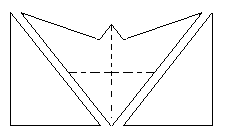
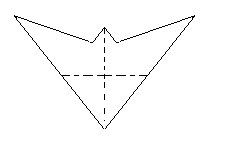 Now that we have removed most of the weight from the paper, we can begin the actual construction process of our World Class Paper Glider. We need to use some of the remaining weight of the paper and compress it into a small area as close to the front as possible to provide the correct centre of gravity. Since we already have a crease across the paper which defines the front of the glider, we know where to fold the point.
Now that we have removed most of the weight from the paper, we can begin the actual construction process of our World Class Paper Glider. We need to use some of the remaining weight of the paper and compress it into a small area as close to the front as possible to provide the correct centre of gravity. Since we already have a crease across the paper which defines the front of the glider, we know where to fold the point. 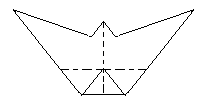
 Continue to fold the paper one more time up to the reference crease before folding on the crease itself. This will concentrate the weight of the paper near the front of the glider. Finally, folding the reference crease will expose the front of the glider.
Continue to fold the paper one more time up to the reference crease before folding on the crease itself. This will concentrate the weight of the paper near the front of the glider. Finally, folding the reference crease will expose the front of the glider. 
 Press down on the centre - bottom of the glider with your fingernail while folding each wing. Because the paper has so many layers at the front, it is important to keep it flat while folding. You may note that the wings are perfectly symmetrical. Aren't they? Try again until they are. The wings are elegant, compound tapered, and high aspect ratio. All these attributes are important aerodynamically and help account for the graceful flight characteristics inherent in those types of gliders.
Press down on the centre - bottom of the glider with your fingernail while folding each wing. Because the paper has so many layers at the front, it is important to keep it flat while folding. You may note that the wings are perfectly symmetrical. Aren't they? Try again until they are. The wings are elegant, compound tapered, and high aspect ratio. All these attributes are important aerodynamically and help account for the graceful flight characteristics inherent in those types of gliders. 
 See that little piece of paper sticking out the top? Want to rip it off? No! Its there for a good reason. It is left there to hold your glider together. It is lighter than tape, glue, or staples. Just fold it forward and remember that you are looking at the bottom of the glider. Now that you've completed the easy part of your glider's construction, it will need a few more very important creases then properly shaped into its best flight mode. If you try to fly it now, it will spiral into the ground and likely pop open on impact.
See that little piece of paper sticking out the top? Want to rip it off? No! Its there for a good reason. It is left there to hold your glider together. It is lighter than tape, glue, or staples. Just fold it forward and remember that you are looking at the bottom of the glider. Now that you've completed the easy part of your glider's construction, it will need a few more very important creases then properly shaped into its best flight mode. If you try to fly it now, it will spiral into the ground and likely pop open on impact.
Fold your glider in half making sure the tab is on the outside and the wings line up as closely as possible. Then fold the wings down to form a 'V' shaped keel. This keel holds the tab tightly closed to prevent the glider from coming open during flight. I sincerely doubt that there is any aerodynamic benefits to this keel other than perhaps some small amount of lateral stability. You should end up with something that looks like these small images. The progression shows both wings folded up to both wings folded down. The double image represents the glider flattened - out, rear view and bottom view respectively.

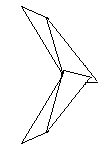


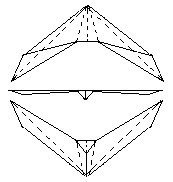 Flatten it again and fold a long crease from tip to nose on both wings. This important crease performs three distinct functions. First, from an engineering standpoint, it provides a stiffener for the wing, making it more rigid. Second, it creates a camber to enhance the lift generating characteristics of an otherwise flat plate aerofoil. Third, it inadvertently adds an essential twist to the wing. The twist is important for longitudinal dihedral, or pitch stability if you prefer. The difference in angle of attack from the root to the tip is known as washout. The washout prevents the wingtips from stalling before the root. It is very difficult to draw an illustration of this effect. This triple view shows top view, rear view, and bottom view respectively. Also I cannot show you, without some animation, is how to score the under-surface of each wing with your fingernail. Try this. Holding a piece of scrap paper between your thumb pad and index fingernail, make tugging motions on the paper to produce tiny scratching creases in the paper. The paper should curl into a compound curve. If you do that on the glider's wings from the root to half span on each wing, you will cause a downward reflex in the trailing edge, a smoother transition in the twist of the wing, and most importantly, the two layers of paper will stick very tightly together to reduce drag.
Flatten it again and fold a long crease from tip to nose on both wings. This important crease performs three distinct functions. First, from an engineering standpoint, it provides a stiffener for the wing, making it more rigid. Second, it creates a camber to enhance the lift generating characteristics of an otherwise flat plate aerofoil. Third, it inadvertently adds an essential twist to the wing. The twist is important for longitudinal dihedral, or pitch stability if you prefer. The difference in angle of attack from the root to the tip is known as washout. The washout prevents the wingtips from stalling before the root. It is very difficult to draw an illustration of this effect. This triple view shows top view, rear view, and bottom view respectively. Also I cannot show you, without some animation, is how to score the under-surface of each wing with your fingernail. Try this. Holding a piece of scrap paper between your thumb pad and index fingernail, make tugging motions on the paper to produce tiny scratching creases in the paper. The paper should curl into a compound curve. If you do that on the glider's wings from the root to half span on each wing, you will cause a downward reflex in the trailing edge, a smoother transition in the twist of the wing, and most importantly, the two layers of paper will stick very tightly together to reduce drag.
Do not squeeze the glider's keel together like you are throwing a paper dart or airplane. This glider does not have a trajectory. It follows a distinct and flowing flight path. With the glider at rest, and the keel in its natural 'V' shape, is the shape it must be flown in. Do not throw the glider. Gently push it on its way and if it is trimmed properly, it will find its glide speed and settle into its flight path. If it exhibits stalling characteristics, gently untwist the wings by flattening the camber crease and try again. If it turns left, then the left wing has more camber and or twist than the right wing, and vice versa. If it spirals into the dirt, then increase the amount of camber and or twist in both wings and try again. Try to keep the wings as horizontal as possible, by this I mean that you should have no anhedral or dihedral because swept wings take care of roll stability. But that's another story...